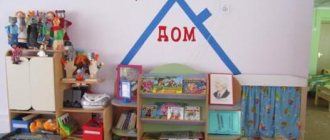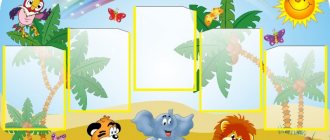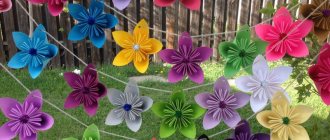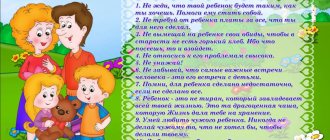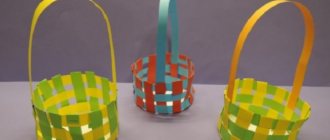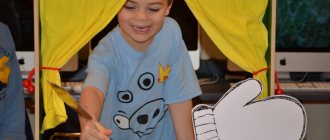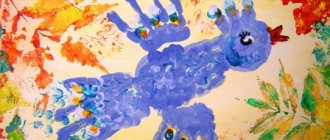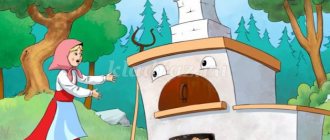A preschool educational institution is an organization where primary public education of children is carried out, the first link of public education in most developed countries. Toddlers and older preschoolers are in kindergarten from about seven in the morning until five or seven in the evening, learning the minimum necessary communication skills, playing, and preparing for school. To prevent separation from parents for the whole day from being too traumatic for the baby, conditions similar to those at home are created in the preschool educational institution - an abundance of toys, friendly teachers, and the opportunity to sleep during the day. An important factor is the design of the kindergarten - beautiful, comfortable premises, safe areas.
Design principles
When choosing a kindergarten, the first thing parents pay attention to is the interior. This is the calling card of the institution; it is designed harmoniously, in a memorable manner. Children should feel comfortable in it so that they want to return there every day.
The basic principles of the improvement project are approximately the following:
- compliance with the name - the “Bee” kindergarten should have in its design figurines of bees, black and yellow elements, and the “Fairy Tale” kindergarten should have images of heroes of famous fairy tales;
- the walls of corridors and lobbies are painted with various scenes so that children find it interesting to look at them;
- clear zoning - each group must have a separate locker room, bedroom, games room, in harmony with each other;
- the interior for children of different ages is decorated with different pictures - for the younger group, the plots of “Ryaba Hen”, the cartoon “Little Kids” are suitable, for older ones - fairy tales about “The Sleeping Beauty”, “Ivan the Tsarevich”, etc.;
- The design materials chosen are environmentally friendly, predominantly natural.
Materials, finishing methods
Basic, most commonly used materials:
- tree;
- Fiberboard;
- MDF;
- plastic;
- drywall;
- ceramic tile;
- dye;
- wallpaper.
All materials must be harmless to children’s health and have radiation safety certificates. Ceilings are most often whitewashed and painted with water-based paint. The walls are made smooth so that they are easy to clean, and the floors are not slippery. The walls, floors of sanitary premises, catering units are decorated with tiles, oil paint, and decorative plaster. The floors in the groups are made of wood, laminated, natural linoleum, without cracks or protruding parts. In cold regions, heated floors are preferred. In groups, rugs and rugs are laid on the floor.
The furniture is also selected to be environmentally friendly, comfortable, and light. Preferably one that “grows with the child” - adjustable in height. It can be hard or soft.
Decorative umbrella made of fabric and knitting needles
An umbrella for little fashionistas can be made from scrap materials.
To do this, you need to take thin knitting needles (6 pieces), fabric, plasticine and glue.
Place the metal sticks together and tie them with twine at the bottom. Bend them at the top to form a base.
After this, make a handle from plasticine and secure the end of the knitting needles. If you want something more reliable, you should resort to using plastic (baked polymer clay). It is a little more difficult to knead and work with than with plasticine, but after baking it will harden and will not lose its shape.
Cut a piece of round fabric of a size that fits the individual workpiece. If desired, it is possible to treat the edges or the entire fabric with paints, lace, rhinestones or artificial flowers.
The entire length of the handle can be decorated with decorative beads and ribbons.
After the fabric is glued, it is recommended to remove excess glue with a napkin from the inside of the umbrella so that there are no stains left on it.
In the final version, the umbrella craft should look something like this:
Color palette
Rooms with windows facing north are painted in warm colors - beige, light yellow, orange-pink, peach. “Southern” rooms are decorated in cold colors – light blue, pale green, soft violet. Up to 25% of the area can be painted more brightly, but use a minimal amount of aggressive colors.
With the help of color, rooms are zoned - individual places are highlighted with bright colors and pictures.
How do different colors affect children?
- pink – calms, the child feels safe;
- blue – promotes concentration and relaxation;
- blue – gives calmness, relieves internal tension;
- yellow – helps to communicate, learn new skills;
- red – gives self-confidence, in large quantities increases anxiety;
- green – improves brain function, too bright can tire you.
From circles
Crafts for kindergarten in the form of umbrellas are a hot topic, because every season teachers come up with new tasks for children. To make this accessory from circles, you need colored paper (coated paper will turn out more beautiful and brighter). Using a compass, draw 8-10 circles of the same size. If desired, you can make a rainbow, one-color or two-color version. The resulting circles should be folded in half - these are blanks for crafts.
Now you need to take one folded circle and grease it with a glue stick on top, leaving the lower tip untouched. Place another circle on the sticky side and glue well. Next, connect the next piece. Do the same with all the circles. When the main part is finished, you need to make a handle for the umbrella. For this you will need colored wire. It can be purchased at craft stores. You need to leave the main part straight and twist the tip inward. Attach it with hot glue to the head of the umbrella.
Design of individual rooms or zoning
Zoning of space occurs by dividing it into functional zones with defining boundaries.
What are the boundaries?
- volumetric - partitions, screens, walls, furniture, curtains;
- spatial – these are different floor heights in different zones, colors, lighting, architectural elements;
- combined - the space is simultaneously divided and connected, these are stained glass windows, grilles, curtains, columns, arches;
- translucent, completely transparent - this is how physical separation is achieved while maintaining a visual connection.
Flexible zoning is preferred - prefabricated cabinet structures, sliding partitions, screens, transparent screens. Children often take a direct part in zoning, together with their teachers. Platform podiums with fences and various partitions are often used - straight, angular, curly, of various heights, widths, lengths. The decorative design of the ceiling on holidays will also become an element of division into zones - these are flags, balloons, paper garlands.
Senior groups are often located on the second floor, so the safety and aesthetic appearance of the stairs should also be taken care of. The walls along them should be beautifully decorated - for example, there should be an exhibition of graphic and painting works by students.
Play and study room
Most often, children play and eat in the same rooms. Furniture is selected according to the height of the children - in the younger and older groups it will vary greatly in height.
Posted here:
- tables, chairs;
- racks for books, toys;
- paints, felt-tip pens;
- finished works made by children's hands;
- musical instruments.
The walls are decorated with bright, non-aggressive wallpaper and drawings - developing stories, episodes from fairy tales and cartoons are welcome. In the play area, a soft, warm carpet is laid on the floor. Cabinets, racks for toys, books are selected with minimal risk of injury, are stable, and are well secured. The study area should be sufficiently well lit, visually separated from the play area by a different floor covering, walls, or with the help of partitions. Here children learn to read, write, draw, and sculpt. Zones of various games are separated from each other by decorative houses and screens - a kitchen with a toy set, a railway, a Lego town.
Dining area
The dining room is separated from the playing area by a screen and shelving. For ease of cleaning, do not place a carpet in this place, because children often drop food on the floor, spill it, and scatter it. The furniture here includes tables designed for two to four people, and chairs suitable for the height of the bench. On the wall there is a menu, an explanatory note, which describes and depicts how to properly use a spoon, fork, and napkins. The tables are covered with tablecloths and colorful oilcloths. Cartoon characters are often depicted on the walls eating.
Locker room
This is one of the first rooms where children and their parents find themselves when they come from the street. It is decorated brightly, a variety of subjects are used, wallpaper with images of animals and fairy-tale characters is used. Stands with important information, announcements, schedules, and height meters are placed on the walls. They draw on clothes lockers, stick different letters and pictures on them so that each child can easily remember his own and find where his things are. Long benches are placed in the center of the locker room so that the students can dress comfortably, and a carpet is laid on the floor.
Bedroom
The bedroom is intended for daytime sleep, night rest in the gardens with 24-hour stay. It is decorated in calm, mostly pastel, tones. Thick curtains are hung on the windows - the room should be darkened during the daytime rest. They are selected from natural, eco-friendly materials that suit the style. The structures to which they are attached must be highly reliable, and the fabrics must be practical and durable. You can simply whitewash the ceiling or depict a starry sky on it.
What should a bathroom be like?
Strict requirements are imposed on kindergarten bathrooms. Ceramic tiles are laid on the floor, which are easy to clean; on the walls, such covering should be at least one and a half meters high. In the younger groups, the toilet is equipped with pots, in the middle and older groups - with toilets, washbasins, and mirrors. The older the children, the more spacious this room should be. For older children, toilets are located in stalls, but the doors should not have locks. Each student has his own towel, which he hangs on a hook in a separate compartment. In the showers, drainage is provided through holes in the floor; for safety, rubber mats and wooden pallets are used.
Application
Children's cards always turn out the cutest, so you can invite your child to make them. To prevent the product from looking boring, you should try to diversify it with appliqué.
For this work you will need:
- markers;
- colored and white paper;
- glue;
- scissors.
Fold a white sheet of A4 paper in half and iron it to form a spine. Unfold the sheet and set it aside.
Now you need to take the red paper and fold it into an accordion.
Glue the center of the accordion onto the spine, and then the rest.
All that remains is to finish drawing with a black felt-tip pen the handle of the umbrella, the man in the raincoat and the rain that goes around the umbrella.
This card can be folded if you glue the accordion umbrella strictly in the center. If you wish, you can write there a congratulation on some special day, or not write anything and give it just like that.
Decoration of children's playgrounds
There are two main zones on the territory of the kindergarten:
- recreational - where students walk and play;
- economic - special transport arrives there and performs loading and unloading.
Experts recommend making playgrounds different - for children of different ages, their communication, games, and any events. The presence of natural areas is complemented by play elements made from natural materials. Also, convenient access to the territory of the preschool educational institution is provided, and the presence of short-term rest areas for adults who look after children is encouraged. Various techniques of modern landscape design are used.
On the site there are:
- sandboxes;
- swing;
- horizontal bars;
- stairs;
- sun canopies;
- tables, chairs, benches;
- equipped places for sports games;
- houses, gazebos;
- plot sculptural compositions.
Some of the decor is easy to make with your own hands - animals from car tires, ladders from wooden slices, logs, miniature buildings from plywood, flower beds, alpine slides. Trees are made from colored plastic bottles, flower bed fences are made, paths are lined with pebbles painted to look like ladybugs and beetles. All decorative elements are painted with bright colors, and the walls of the kindergarten building are decorated with fairy-tale scenes.
Often the garden building has a gym or a swimming pool - children need to develop physically. The gym is equipped with a wall bars, balls, trampolines, basketball hoops, hoops, and skittles. The swimming pool must comply with safety standards, be equipped with life buoys, and be of shallow depth.
Craft from napkins
Crafts in the form of umbrellas are easy to make with your own hands.
An umbrella can be made from napkins in origami style and made with applique. If desired, you can add lace ribbon and other decorations to them.
In order to make a three-dimensional umbrella, you will need colored craft wire and just one napkin. It should be folded into a cone and glued. Thread the wire in the center and bend it from the bottom. Additionally, you can decorate the base of the umbrella with drawings, rhinestones or colored ribbons.
Creating a living corner
A living corner is a developmental area that teaches children the first skills of caring for animals and plants, allowing them to observe their behavior and development.
People most often living here are:
- hamsters;
- rabbits;
- Guinea pigs;
- decorative mice, rats;
- parrots, canaries;
- turtles, lizards;
- certain types of aquarium fish.
Various indoor plants in pots are often placed here - it is important to choose exclusively non-poisonous ones that cannot cause allergies or injure curious children with thorns or thorns. Children give animals food, clean cages under the supervision of adults, water flowers from watering cans, learning about the world of flora and fauna. All necessary equipment is stored here - children learn to use it.
Junior group. Early childhood, nursery. Children 1-4 years old
Traffic rules corner for the little ones for an early age
corner for the little ones (early ages)
Galiullina Elvira Kamilevna Goal: To develop basic knowledge about the rules of safe behavior on the road. Objectives: 1. Teach children to recognize traffic lights: red and green. Form a stable idea of...
Model of a corner for sensory development for children from 1 to 3 years Age group : from 1 to 3 years Purpose: Formation of sensory abilities in children 1-3 years old in a preschool setting. Objectives: 1. continue to develop logical thinking in children. To form general sensory ability, i.e. ability to use sensory standards (5 colors of the spectrum,...
All about decor and choice of textiles
Textiles are selected to match the overall color scheme. All fabrics are preferred natural, environmentally friendly, fireproof. Dust should not accumulate on them; bedding fabrics must not contain components that can cause allergies. High-quality textiles will not have to be changed after one or two years; they will not fade in the sun or lose their appearance. Pupils, together with adults, make crafts from fabrics, paintings, appliqués from felt on a linen base, sewn toys to decorate the head’s office. Themes and plots used are different.
Rag wall organizers for stationery and interior dolls will also decorate the interior of the room. In the bedroom there are decorative panels depicting sleeping animals, in the dining area there are textile paintings where cartoon characters eat and prepare food. Several textile tents are placed in the games room, in which some children can hide and retire if necessary.
Fabric pockets for a children's locker are easy to make yourself. To do this, you will need about a meter of fabric, from which two pieces 30 by 80 cm are cut, two pockets 40 by 20 cm and 40 by 15 cm. An elastic band is sewn into the upper parts of the pockets, on which they are slightly pulled together, sewn to the base one after the other, starting from the bottom. Afterwards the second part of the base is attached, a strip of plastic is inserted at the top and bottom for rigidity. The edges are decorated with bias tape and strips of the same fabric. Loops are sewn into the upper part on which the pockets will hang. They store spare panties, socks, gloves, a hat, a comb, and office supplies. If desired, the design is decorated with embroidery, applique, and beads.
Umbrella made of leaves - step-by-step production
To make a beautiful decorative umbrella from leaves, you must have:
- old umbrella;
- leg-split;
- dry leaves;
- PVA glue;
- decorative elements of autumn (optional).
First you need to remove the cover from the old umbrella, leaving only the frame. Anything removed from the old item can be thrown away or used in addition to decorative items on the new item.
Wrap the base generously with twine. Now you need to take a lot of dry leaves and plant them on glue, and add decorative elements like cones, acorns, pumpkins, etc. around the entire perimeter.
After drying, the leaf umbrella is ready. The method is simple, does not take much time, and every child can definitely repeat it.
